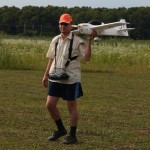 About one year ago I bought a very, very cool foamie. Expensive as hell for a foamie, but it flies heavenly. I’m talking about Multiplex‘s Acromaster, a very well engineered (German, d’oh…) air model. While the technical specs are rather common (around 1010 mm – 1,01 m – wingspan, 1120 mm length, powered by a 3536-class electric motor developing almost 1,3 kgf of thrust when using an 11×5,5 in propeller and powered from a 11,1 V (3S) 2200 mAh, 20C Li-po battery pack) the plane is wonderful to fly. The first time I flew it (during this contest) I’ve been amazed by its fantastic agility and very good aerobatic capabilities but also by its ability to react calmly to inputs (in a different setup, of course), which makes it both a great 3D plane and a very good second plane. I’ve been witness to this usage, when Romulus dared to fly it after only three months spent with R/C gliders.
About one year ago I bought a very, very cool foamie. Expensive as hell for a foamie, but it flies heavenly. I’m talking about Multiplex‘s Acromaster, a very well engineered (German, d’oh…) air model. While the technical specs are rather common (around 1010 mm – 1,01 m – wingspan, 1120 mm length, powered by a 3536-class electric motor developing almost 1,3 kgf of thrust when using an 11×5,5 in propeller and powered from a 11,1 V (3S) 2200 mAh, 20C Li-po battery pack) the plane is wonderful to fly. The first time I flew it (during this contest) I’ve been amazed by its fantastic agility and very good aerobatic capabilities but also by its ability to react calmly to inputs (in a different setup, of course), which makes it both a great 3D plane and a very good second plane. I’ve been witness to this usage, when Romulus dared to fly it after only three months spent with R/C gliders.
So I bought it in late August last year. I wanted to buy the electronics for it one month later, in September, but an incident with my car, just two days before placing the order for the plane parts, left me with empty pockets. So I had to wait around 9 months before being able to finally place the order for the said parts – which finally happened in May this year. Therefore you can imagine my excitement when I laid hands on the parts package at the customs’ office. Motor, servos, connectors and 5 battery packs. Woo-hoo! Let’s put it all together!!!
I wasted no time after I placed the order (it took the seller almost a month to send the package due to an item on backorder, which I gave up on after a while) and I glued all plane parts together. It’s not a very difficult task, but it uses LARGE quantities of cyanoacrylate adhesive (superglue) which smells, well, awful. And you have to be very quick and exact when you join the parts together after laying the glue on the surfaces, since this is a very fast-cure adhesive, and if you want to move the parts one over the other after 5 seconds of them being pushed into one another – good luck! Fortunately my handcraft skills, although very poor, were good enough to allow me to make all these operations quite well.
One of the great things in this little bird is that it does not require trimming / adjustment. All parts fit perfectly into one another. The only problems I had were at the tail surfaces’ servos, which were a little too short (7 mm) and a little too deep for their places. While the shortness was easy to fix using a couple of small balsa wood pieces, the depth issue was almost a showstopper. The servos’ sockets are on opposing sides of the plane, and they are deep enough to almost touch each other when firmly seated in their final positions (there’s less than 1 mm distance between the bottoms of their cases). Fortunately the cases have that small gap and I’ll eventually add some thin insulating foam between them in order to prevent the vibrations and the possibility that they come into direct contact and the casings wear off.
Other than that, no more problems: the CG (Center of Gravity) is almost perfect – maybe a very little tail heavy, despite all electronics (battery, motor controller and receiver being placed as forward as possible) and the plane flies just great after setting the right motor angles to the right and downwards). Another example of German technical ingenuity: the motor is mounted on a plate designed to allow easy angle adjustments by tightening or loosing four screws in its corners.
The plane now flies almost without any control surface trims. It flies great both normal and inverted, level and vertical. It allows great aerobatic maneuvers (snaps, hover – It hasn’t been flown yet by a pilot capable of torque rolls or rolling harriers, for example) and it lands like a feather. The only thing left for me to do is to apply the stickers to the wings and on the lower side of the fuselage.
So, from now on, flying is more fun than work. No more cleanup after the flight day (well, maybe cleaning the dust and grass marks from the wheels, fuselage bottom and wingtips in case of a steep side banked-landing -had a couple of these). No more hassle with refueling the tank – just replace the pack, put the flown one to recharge, and take off again. And I didn’t mention the easiness to assemble / disassemble it: you simply push the two wings in place (the reinforcement carbon tubes are well stuck in one of the wings) and that’s it. No screws to tighten, no springs to stretch. Just “push’n’play” :). And most important: it fits very easily in the car. Not that the Extra doesn’t, but this little one can be held my Milady when we go to the field with Maxie – who occupies the entire back of the car and is very unhappy when she has to accept someone else next to her, thus giving up one of the three seats. Oh yes, and the wings fit perfectly next to the rear window!
The last thing I need for this one is the 4-in-1 charger with the balancing adapters. Hopefully I’ll be able to get it in August – it’s simply uncomfortable to only have one charging port available at a time when you’re in for a full day of flying. And it is also good for the indoor practice when you use pack after pack after pack…
Photos will come later, since they’re not with me today.


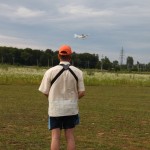
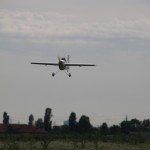
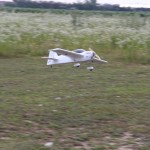
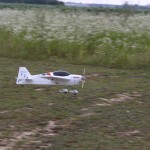


[…] This post was mentioned on Twitter by Mircea Popescu, Loredana Pascal. Loredana Pascal said: So, do you like the Acromaster? http://ow.ly/2f5KX […]